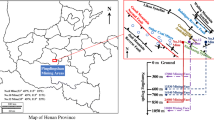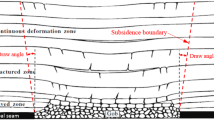Summary
Some aspects of subsidence caused by longwall coal mining are analysed using the finite element method. Results of the analysis are compared with a true mine panel, where measurements on subsidence were available. Rock deformations in the overburden were modelled by using an elasto-plastic constitutive model. The study indicates that the shape of the subsidence profile can be predicted reasonably well by using nonlinear finite element analysis.
Similar content being viewed by others
References
Adamek, V. and Jeran, P.W. (1981) Evaluation of existing predictive methods for mine subsidence in the United States, inProceedings, Workshop on Surface Subisidence Due to Underground Mining, West Virginia University, Morgantown, pp. 88–99.
Aggson, L.R. (1978)Coal Mine Floor Heave in the Berkeley Coal Bed, Report of investigation, RI8274, US Bureau of Mines.
Brown, R.E. (1968)A Multi-Layered Finite Element Model for Predicting Mine Subsidence, thesis presented to Carnegie-Mellon University, Pittsburgh.
Dahl, H.D. (1969)A Finite Element Model for Anisotropic Yielding in Gravity Loaded Rock, thesis presented to the Pennsylvania State University.
Dahl, H.D. (1972) Two and three dimensional elastic-elasto plastic analysis of mine subsidence, inProceedings, Fifth International Strata Control Conference, London, Paper No. 28.
Dahl, H.D. and Choi, D.S. (1981) Measurement and prediction of mine subsidence over room and pillar workings in three dimensions, inProceedings, Workshop on Surface Subsidence Due to Underground Mining, West Virginia University, Morgantown.
Desai, C.S. and Siriwardane, H.J. (1983)Constitutive Laws for Engineering Materials, with Special Reference to Geologic Media, Prentice-Hall, Englewood Cliffs, New Jersey.
Drucker, D.C. and Prager, W. (1952) Soil mechanics and plastic analysis of limit design,Quarterly of Applied Mathematics,10, July.
Mozumdar, B.K. (1974)A Mathematical Model of Ground Movement Due to Underground Mining, thesis, Pennsylvania State University.
Munson, D.E. and Eichfeld, W.F. (1980)European Empirical Methods Applied to Subsidence in U.S. Coal Fields, Report, SAND80–1920, Sandia National Laboratories.
National Coal Board (1975)Subsidence Engineers Handbook, London.
Pariseau, W.G., Voight, B. and Dahl, H.D. (1970) Finite element analyses of elastic-plastic problems in the mechanics of geologic media: an overview, inProceedings, Second Congress, International Society for Rock Mechanics, Belgrade.
Ranson, B.B., O'Rourke, E. and Rey, P.H. (1982)Design and Demonstration of Subsidence Monitoring System, Report, Woodward-Clyde Consultant, Contract No. DE-AC01-78ET 1220, sponsored by US Department of Energy, 285 pp.
Siriwardane, H.J. (1984)User's Manual and Background for a Computer Code for Nonlinear Two-Dimensional Finite Element Analysis of Geotechnical and Mining Problems, Report, Department of Civil Engineering, West Virginia University, Morgantown.
Siriwardane, H.J. and Amanat, J. (1983)Finite Element Analysis and Prediction of Subsidence Caused by Underground Mining, Report CE/GEO-83-2, Department of Civil Engineering, West Virginia University, Morgantown.
Siriwardane, H.J. and Amanat, J. (1984) Prediction of subsidence in hilly ground terrain using finite element method, inProceedings, 2nd International Conference on Stability in Underground Mining, AIME, Lexington, Kentucky, August.
Siriwardane, H.J. and Desai, C.S. (1983) Computational procedures for nonlinear three-dimensional analysis with some advanced constitutive laws,International Journal of Numerical and Analytical Methods in Geomechanics,7, No. 2.
Siriwardane, H.J. and Moulton, L.K. (1984) Direct and indirect influence of mining related to subsidence on structural damages: a case study, inProceedings, International Conference on Case Histories in Geotechnical Engineering, St Louis, Missouri.
Sutherland, H.J. and Schuler, K.W. (1981) A review of subsidence predicting research conducted at Sandia National Laboratories, inProceedings, Workshop on Surface Subsidence due to Underground Mining, West Virginia University, Morgantown, pp. 1–16.
Voight, B. and Pariseau, W. (1970) State of the predictive art in subsidence engineering,Journal of the Soil Mechanics and Foundations Division,96, 721–50.
Zienkiewicz, O.C. (1977)The Finite Element Method in Engineering Science, 3rd edn, McGraw-Hill, London.
Author information
Authors and Affiliations
Rights and permissions
About this article
Cite this article
Siriwardane, H.J., Amanat, J. Analysis of subsidence caused by underground mining. International Journal of Mining Engineering 2, 271–290 (1984). https://doi.org/10.1007/BF00881117
Received:
Issue Date:
DOI: https://doi.org/10.1007/BF00881117




